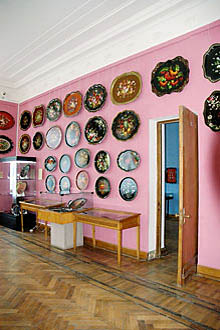|
 |
The All-Russian Museum of Applied and Folk Art
|
|
 |
 Opened in 1981, this relatively young museum is something of a mixed bag, combining a number of private collections gifted to the state that would otherwise be homeless. The emphasis is on Russian decorative art, with pride of place going to the extensive collection of antique lacquer miniatures, but there are also collections of toys from around the world and of European needlework.
Opened in 1981, this relatively young museum is something of a mixed bag, combining a number of private collections gifted to the state that would otherwise be homeless. The emphasis is on Russian decorative art, with pride of place going to the extensive collection of antique lacquer miniatures, but there are also collections of toys from around the world and of European needlework.
The museum has over 65,000 exhibits altogether, and other collections of note include those of Russian 19th century fine furniture, Faberge jewelry and Soviet porcelain, pottery and glassware.
The variety of the displays is such that you're bound to find something here of interest and, although the museum is a little dark and foreboding, the ramshackle nature of the exhibits gives it a certain charm, too.
Opening hours: daily from 10:00 to 18:00, closed Fridays and the last Thursday of each month.
|
 |
 |
The history of the Museum's buildings is as chequered as the collection. The Museum is situated in the former estate of Count Osterman, built at the end of the 18th Century. The three-storey palace dates from 1786, and was once surrounded by a landscaped park.
In 1812 the palace was badly damaged by fire, and the site was sold to the Moscow Church Seminary, which worked here until the Revolution. Further buildings were added within the grounds to house the seminary.
In Soviet times, the building which houses the Museum itself - a tasteful example of Stalinist Classicism erected on 1949 - was the home of the Presidium of the Supreme Soviet and Soviet of Ministers, before eventually being handed over to the Museum at the start of the 1980s.
|
 |
 |
 |
 | • ADDRESS AND CONTACT INFORMATION |
 |
 |
Address: 3, Delegatskaya Ulitsa, Moscow, 127473, Russia
Telephone: +7 (495) 921-0139, +7 (495) 923-1741
Transport: From Mayakovskaya, Novoslobodskaya or Sukharevskaya metro stations, take trolleybuses B, 10 or 47 to the Teatr Kukol (Puppet Theater) stop.
|
 |
|
 |
|

 Opened in 1981, this relatively young museum is something of a mixed bag, combining a number of private collections gifted to the state that would otherwise be homeless. The emphasis is on Russian decorative art, with pride of place going to the extensive collection of antique lacquer miniatures, but there are also collections of toys from around the world and of European needlework.
Opened in 1981, this relatively young museum is something of a mixed bag, combining a number of private collections gifted to the state that would otherwise be homeless. The emphasis is on Russian decorative art, with pride of place going to the extensive collection of antique lacquer miniatures, but there are also collections of toys from around the world and of European needlework.